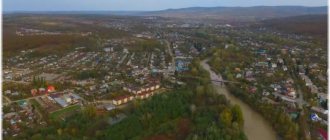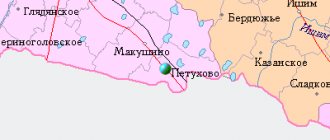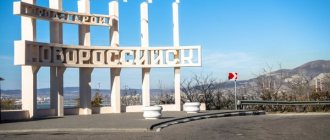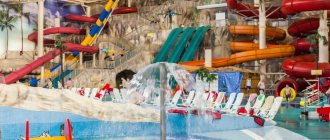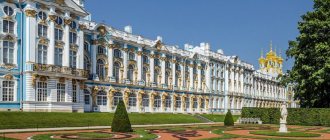City in Krasnoyarsk Krai, Russia
| Divnogorsk Divnogorsk | |
| Town[1] | |
| View of the Yenisei River from the city pier of Divnogorsk | |
| Flag Coat of arms | |
| Divnogorsk | |
| Divnogorsk Divnogorsk Show map of Russia Divnogorsk Divnogorsk (Krasnoyarsk region) Show map of Krasnoyarsk Territory | |
| Coordinates: 55°57′34″N 92°21′43″E / 55.95944 ° N W. 92.36194 ° E / 55.95944; 92.36194Coordinates: 55 ° 57′34″ N 92°21′43″E / 55.95944°N 92.36194°E / 55.95944; 92.36194 | |
| A country | Russia |
| Federal subject | Krasnoyarsk region[1] |
| Based | 1957[2] |
| City status from | 1963[2] |
| Height | 260 m (850 ft) |
| population (2010 Census)[3] | |
| • General | 28,272 |
| • Evaluate (2018)[4] | 29,246 (+3.4%) |
| Administrative status | |
| • Subordinate | region city of Divnogorsk[1] |
| • Capital from | region of Divnogorsk[1] |
| Municipal status | |
| • Urban district | Divnogorsk City District[5] |
| • Capital from | Divnogorsk City District[5] |
| Timezone | UTC + 7 (MSK + 4 [6]) |
| Postal code(s)[7] | 663090, 663091, 663093, 663094 |
| OKTMO I WOULD | 04709000001 |
| Web site | www.divnogorsk-adm.RU |
Divnogorsk
(Russian: Divnogorsk, IPA: [dʲɪvnɐˈɡorsk]) is a town in Krasnoyarsk Krai, Russia, located on the Yenisei River, 40 kilometers (25 mi) southeast of Krasnoyarsk, the administrative center of the region. Population: 28,272 (2010 Census);[3]30,137 (2002 Census);[8]29,963 (1989 Census).[9]
Story
Paleolithic remains discovered on the western outskirts of the city indicate that the land was inhabited more than ten thousand years ago.
Where the city stands, there was the village of Ovsyanka (Russian: с. Овсянка), founded in 1671.
In 1888, on the site of the modern Divnogorsk chastity priest Philaret, the Krasnoyarsk Znamensky male monastery was founded (closed in 1920); construction of which began on August 19 of the same year. Over time, the monastery turned into the village of Skete. The monastery operated a brick factory, a tar factory, a candle factory, and various workshops. The monastery was the first above the Krasnoyarsk pier, where the ships landed on the sandy shore just below the Filaretov stream. All that remains of the monastery buildings is a wooden two-story house, converted from an old church (now art studios are located here). At the beginning of 1920, the monastery was closed and turned into an orphanage; in 1921, it was transformed into children's labor camp No. 2 for orphans. In 1930, the orphanage and the experimental forestry and subsidiary farm of the Krasnoyarsk Forestry Technical School were disbanded in the village. At this time there were about a dozen families. Received city status in 1963.[2]
A day outside the city: Divnogorsk and Ovsyanka
I’m going there to tell you how to make the most of another Sunday or Saturday.
Address : Krasnoyarsk-Abakan road (M54), Costs : round trip travel by car (about 85 km, 9 liters of gasoline, 300 rubles), entrance to the museum-estate in Ovsyanka (100 rubles ticket, 50 rubles photography), excursion to library in Ovsyanka (40 rubles) Intended audience : any Recommended season : any Pros : beauty of the landscape, new places, knowledge Cons : dull appearance of provincial towns
In summer, traveling towards the satellite city near the marvelous mountains is very pleasant. The winding track improves your driving skills, the cool river breeze caresses your hair, and the almost fresh asphalt prevents you from bouncing on bumps. The main thing is that you don’t end up in a long line of cars going to the lakes of Khakassia, otherwise there are solid advantages.
If you do not have a personal car, but want to visit Divnogorsk, choose the route by bus. They run regularly from Bridge Square, bus and railway stations, so you won’t have to wait long.
Route track
The first point of our program is hydroelectric power station. A creation of human hands, which is a must-see. To look at the station from a close distance, you need to cross the bridge in front of it, drive a little more along the highway, at the first asphalt turn - to the left, then - the path to the kingdom of power lines and the descent to the water itself. Admire the views, admire and remember that once upon a time we were promised free electricity from every outlet.
Dream and go to Divnogorsk. There are also places worthy of your attention here. It is best to leave your car (or get off the bus) at the bus station. This is, perhaps, the very central point of the town from which it is most convenient to start your walking journey.From this square the Divnogorsk people set off to storm the Yenisei
Photo: Maria Ruskova
It is worth paying attention to the names of city streets. Ordinary ones (Teatralnaya, Sayanskaya, Nagornaya) coexist with almost exotic ones (for example, Patrice Lumumba and Julian Grimau). And they are neighbors for a reason: for example, the street named after Patrice Lumumba used to be called 2nd Radial, but was renamed in honor of the national hero of the Congo. After the murder of the latter, concerned Divnogorsk residents went to rallies out of solidarity with the people of the Congo. And already on April 22, 1961, the street began to proudly bear a new name.
The names of Divnogorsk streets are sometimes not so obvious
Photo: Maria Ruskova
Up the street is the path to the ski resort, which in winter attracts ski lovers. A poster on the Divnoye sports hotel promises active leisure even in the warm season, but no particular activity has been noticed on the green slopes. But it’s quite possible to walk along the paths in the forest with friends or family - and this is another way to spend a day off.
Go back down and start walking down the full steps to the embankment. Along the way, you will come across a monument to Bochkin and other builders of the hydroelectric power station, the city House of Culture in a very, very poor condition (it doesn’t even have any identification marks), Lenin, monuments to war heroes and a stone tent in honor of the first builders of the station.
If by the time you return to the bus station square, you need a snack, you can arrange it at a kiosk by the road. In addition to pasties and snacks, there are pies of all kinds (about 20 rubles apiece), drinks and other food that will not allow you to go hungry. For those who don’t have enough sights, we can suggest visiting the Divnogorsk Art Museum on Nagornaya Street.
Leaving Divnogorsk behind, we return to Ovsyanka - the homeland of Viktor Astafiev. And it seems that all the sights of the locality are in one way or another connected with the life of the great writer. Follow the signs to visit the estate museum (3 buildings) and the library.
The Russian village will captivate
The Astafiev Memorial House-Museum is your first point for exploring the sights of the village. It consists of three buildings: the house of Catherine’s grandmother, the house where Astafiev spent the last 20 years of his life in the summer, and an exhibition on the writer’s works. You will have to pay 100 rubles for entrance tickets, and if you want to take pictures against the backdrop of village everyday objects - another 50 rubles.
The house where the writer spent his childhood seems the most colorful and interesting. Here you can look into the Russian stove, examine the Easter cakes on the table, and learn about the arrangement of a Russian hut. The insult is that the museum curators do not give any information, there are no signs, so you get purely aesthetic pleasure from meeting with antiquity. The same applies to the house where Astafiev spent the summer at the end of his life. But here the museum curator turns out to be a little more talkative. The third house is an exhibition of the writer’s works. Representatives of the taiga fauna, excerpts from works on plastic stylized as wood, hunting items - there are signs and information from the caretaker of two small halls. But you can immerse yourself in the personality of Viktor Astafiev in the library, so I strongly recommend that you visit the darkening building on the extreme street of the village. For 40 rubles you will get an almost hour-long excursion from the touching employees of the institution, walk through all the nooks and crannies of the library, built under the strict guidance of the writer, learn about how things are with today's readers and even watch several videos from the life of a literary genius. It's worth your time and effort. At the end of your trip, you can take a walk to the Ovsyanka embankment. And if you find a place between the crowds of vacationers, you can sit by the water.Ovsyanka embankment
At the exit (or entrance) to the village there is the Church of the Innocent of Irkutsk. A small but beautiful building can be captured as a keepsake. And get on the highway towards Krasnoyarsk.
Church in Ovsyanka
For those who are seriously hungry - the Mayak restaurant at the entrance to the village of Sliznevo. I highly recommend trying “Siberian borscht with lard and wild garlic paste” (235 rubles) and “Grayling in its own juice” (675 rubles), although this time it was decided not to stop by Mayak. If you follow my advice, you will return to your native lands well-fed, satisfied, cultured and pleasantly tired.
A beacon for your hungry belly
A trip to Divnogorsk places is a great way to spend a day away from stuffy Krasnoyarsk. This route will give you food for thought, aesthetic satiety, and even good cuisine. Ideal for those who have guests, or just for a change of scenery for one day.
Photo report: Visiting Astafiev
Divnogorsk
(Krasnoyarsk region)
OKATO code:
04409
Founded:
1957
Urban settlement since:
1957
City since:
1963 City of regional subordination
Telephone code (reference phone)
| 39144***** | 22-40-9 |
Deviation from Moscow time, hours:
4
Geographic latitude:
55°57′
Geographic longitude:
92°23′
Altitude above sea level, meters:
260 Sunrise and sunset times of the Sun and Moon in the city of Divnogorsk
The city of Divnogorsk in the Krasnoyarsk Territory
Territorial features of the city of Divnogorsk Divnogorsk is located in the spurs of the Eastern Sayan and occupies the right bank of the Yenisei River. The distance from Krasnoyarsk is 20 km. Not far from the city is the mouth of the Mana River. The population is about 29 thousand people. The maximum population of the city was more than 31 thousand inhabitants in 2009. The history of the founding of Divnogorsk 1671 - the founding of the village of Ovsyanka, which is now subordinate to the city. In 1888, a monastery was founded in the village, which was closed in 1920, and its territory became a village called Skete. In 1956, the territory was chosen for the construction of the Krasnoyarsk hydroelectric power station, and from that moment on, Skit became a village of hydro-builders and with the name Divnogorsk (opposite the city are the Marvelous Mountains). In 1963, the village received city status.
Industry of the city of Divnogorsk The basis of the industry is the Krasnoyarsk hydroelectric power station, where the majority of the city's population works today. In Divnogorsk, enterprises also produce automobile wheels, geomembranes, reinforced concrete products, produce sandwich panels and prefabricated structures. There is a factory in the city that produces mine automation. Since the city has a small territory, city buses constantly run in Divnogorsk on only two routes. Educational institutions of the city of Divnogorsk There are 6 secondary schools, one evening school and a gymnasium in Divnogorsk; in addition, the city has a sports school for children, an art school, an art and ecological biological station. There are secondary specialized educational institutions: one lyceum and four technical schools, there is also a branch of the academy and several centers for advanced training. Attractions of the city of Divnogorsk Among the attractions of Divnogorsk are: • Art Museum, which presents exhibitions of works by various famous artists. • Divnogorsk City Museum – here you can get acquainted with the historical and cultural heritage of the city. • Museum of the construction of the Krasnoyarsk hydroelectric power station, where you can learn in detail about the stages of construction of the hydroelectric power station and its influence on the development of the city during certain historical periods. • “Slavs” folk theater. Here you can watch theatrical performances by city activists and figures. • Ski complex and sports hotel “Divny”. • Ski slopes.
